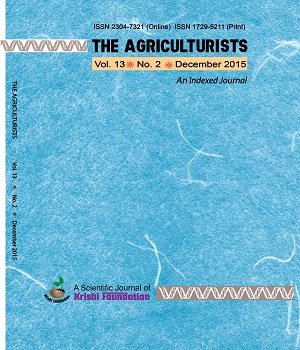Genetic Diversity Analysis in Exotic Hybrid Rice Genotypes Grown During Wet Season in Bangladesh
DOI:
https://doi.org/10.3329/agric.v13i2.26595Keywords:
Genetic diversity, cluster, F1 hybrid rice genotypes, multivariate analysisAbstract
Two experiments were conducted with 43 IRRI developed F1 hybrid rice genotypes (HRDC) for ten agronomic characters in a randomized complete block design to study the genetic diversity through multivariate analysis in Gazipur and Pabna districts, respectively during wet season 2013. On the basis of D2 values, the genotypes were grouped into five different clusters. During wet season, cluster III comprised maximum number of genotypes (15). The data obtained across locations showed that there are significant differences among HRDC genotypes for all growth parameters, yield and yield components. The highest yield (5.65 t ha-1) was observed in HRDC 1341 because of produced heaviest panicle (4.28 g) and the lowest (2.48 t ha-1) in HRDC 1311 because of obtained lowest fertility (49.9 %) and 1000-grain wt. (12.9 g), respectively. The maximum inter-cluster distances were observed between cluster I and V (11.63) and the minimum between cluster III and IV (2.35). The highest intra-cluster distance (1.73) was observed in cluster III and minimum in cluster I (0.00), since it consisted with one genotype. Difference in cluster means existed for almost all the characters studied. Among the characters, growth duration, spikelet panicle-1, fertility (%) and 1000-grain wt contributed the most for divergence in the genotypes. The highest mean values for fertility percentage, panicle weight and 1000 grain wt. but early flowering and short maturing genotypes were grouped into Cluster II followed by Cluster III and IV indicating that the genotypes have genetic potentiality to contribute better for yield maximization of hybrid rice.
The Agriculturists 2015; 13(2) 89-96Downloads
662
626

